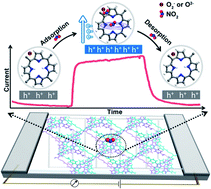Crystalline microporous small molecule semiconductors based on porphyrin for high-performance chemiresistive gas sensing†
Abstract
Organic small molecule semiconductor (OSMS) microporous crystals with strong π–π interactions are rare but have great potential in applications requiring both excellent mass and charge transport. To obtain such a microporous structure, effective molecule design and control over the packing of the OSMS are necessary but still challenging. Herein, we report three meso-tetrakis (4-carboxyphenyl) porphyrin (TCPP) based porous OSMS materials, 1, 2 and 3, whose porosity and π–π interactions among TCPPs were modulated by varying the H-bonding linkage nodes. The relationship among the hydrogen bonding structure, packing mode and sensing performances has been carefully studied. With the largest overlap between porphyrin rings and strongest face-to-face π–π interactions in the prepared compound, 1 showed the best performances. Moreover, it also represents the first RT NO2 chemiresistive sensing material that simultaneously achieved an experimental limit of detection as low as 20 ppb and a time of recovery as short as 0.6 min. This work revealed the key role of H-bonding linkage node in constructing a microporous OSMS and provides a new type of high-performance rt chemiresistive gas sensing material.



 Please wait while we load your content...
Please wait while we load your content...